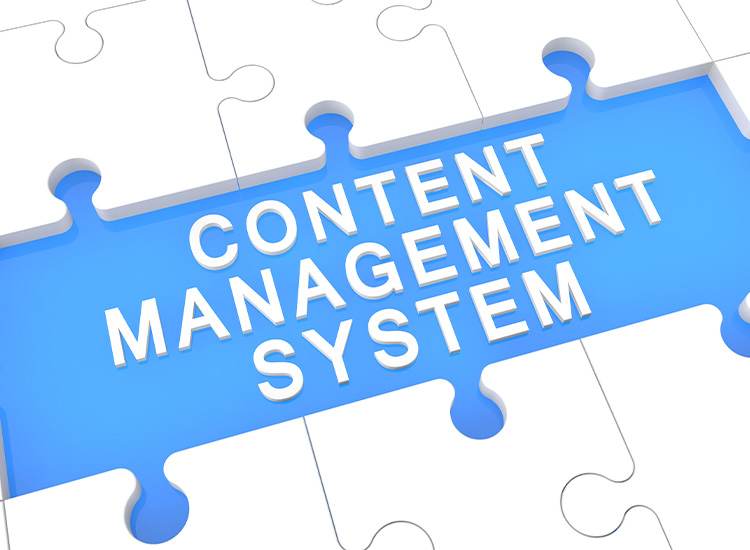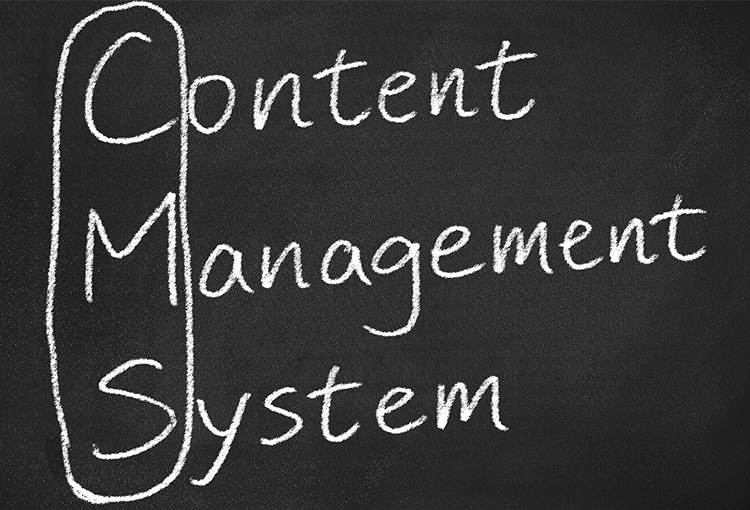
So, what exactly is a CMS, how does it work, and why do you need one? Let’s break it down! All this talk can leave you feeling overwhelmed, but the good news is that a CMS might just be exactly what you need. But what is a content management system or CMS, how does it work and why do you need it?
Well, you’re in the right place! This article will break down everything you need to know about CMS platforms, so you can decide if one is right for you. Let’s get started!
What is a content management system
A content management system or CMS is a software application that allows you to create, store, manage and publish content without any technical development coding knowledge needed. This reduces the need for a full-time development team. All of this is done on one centralised CMS platform making it easier to edit and update your content, helping to seamlessly build your online presence.
Think of a content management system as your behind-the-scenes expert who frees you from the technical burdens of website management, allowing you to focus solely on crafting compelling content and engaging with your audience. By managing the underlying code and infrastructure, a CMS lets you concentrate on creating engaging content, building a stronger online presence and scaling your business.

How does a content management system work
When a user creates new material in a CMS, it is usually saved in a database or file system, along with information like tags, categories, and publication dates. Once the material has been developed and saved, it can be published to a website or another platform using set templates or themes. These templates dictate the content’s layout and design, ensuring that it is shown consistently throughout all pages of the website.
To create this seamless system, a typical content management system relies on several components, with the two key applications being the:
- Content Management Application (CMA) – Which allows users to create, edit, and remove content without needing a deep understanding of HTML.
- Content Delivery Application (CDA) – Which is the technical back end of the system that stores content and delivers it to the CMA of the website.

Additional components of a CMS include:
- Database – The location where site settings, user data, and content are kept.
- Templates – Premade layouts for your content that provides a consistent, professional look and feel.
- Workflow tools: Functionalities for overseeing user collaboration and content approval procedures.
- Plugins: Extensions that provide more capability to the CMS.
- User roles – Provides different levels of access according to the user type. For example, an “editor” has limited access to the system and is only allowed to create and edit content while an “admin” has full control over the entire CMS.
Together all of these components make up the content management system and helps to create a user friendly, easily navigable system that helps you to create, publish, edit and store content all in real time.
Types of content management systems
When looking at the different types of content management systems it is important to categorise them according to your specific needs and goals. The two main types of CMS are differentiated based on use case and embedding.
Popular Content Management Systems (CMS)
When selecting a CMS, it is useful to understand the most popular platforms and their strengths. Here are four common content management systems that cater to various purposes.
1. WordPress
WordPress is the most popular open-source CMS, powering over 43% of all websites worldwide. It is well-known for its simplicity, versatility, and extensive ecosystem of themes and plugins. This CMS is best for bloggers, small-to-medium businesses, and enterprises requiring extensive customisation.
Key Features on WordPress
- Intuitive dashboard for content creation and management.
- Over 50,000 plugins for custom functionality.
- SEO-friendly with tools like Yoast SEO.
- Supports media-rich content and multiple user roles.

2. Joomla
Joomla is a sophisticated and adaptable open-source CMS that is now utilised by around 1.8% of all websites globally. It is suited for developing sophisticated websites and apps, with comprehensive user management and language support. This is best for community websites, social networking sites, and e-commerce platforms.
Key Features
- Robust access control levels (ACL) for user permissions.
- Built-in multilingual support.
- Flexible content management with custom fields.
- Strong developer community for support and extensions.

3. Drupal
Drupal is a highly adaptable and secure open-source content management system (CMS) that powers around 1.2% of all websites worldwide. Large businesses and governments frequently use it to manage complicated content structures and procedures. This is best for large-scale and high-traffic websites, including government and enterprise portals.
Key Features
- Highly customisable through modular architecture.
- Strong access control and user role management.
- API-first approach for headless CMS capabilities.
- High-level security framework with detailed permission settings.
4. Shopify
Shopify is a proprietary SaaS-based CMS that powers around 4.0% of all websites worldwide. It is particularly developed for e-commerce companies, offering an all-in-one platform for effortlessly creating, managing, and scaling online stores.
Key Features
- Intuitive drag-and-drop store builder.
- Secure payment gateway integration.
- Inventory management and analytics.
- Responsive customer support and regular software updates.
A use case CMS looks at the specific purpose it is used for, while an embedding type looks at deployment and the licensing model.
Let’s break these types down further.
Use Case Content Management Systems:
- Web Content Management System (WCMS): Ideal for creating, organising, and maintaining websites with lots of dynamic content, like articles and images.
- Enterprise Content Management (ECM): Serves as a central hub for large companies to organise, collect, store and deliver unstructured data such as emails.
- Component material Management System (CCMS): Used to organise content at a granular level, managing components such as words, phrases, paragraphs, and images in a central repository. This allows it to serve as a reliable channel for distributing information across various devices.
- Digital Asset Management System (DAM): Allows users to sort, upload, track and share digital assets like videos, documents and images.
Read More: Benefits of Integrating Social Media into Your Website

Embedding Content Management Systems:
- Open-Source CMS: A platform that makes its source code publicly accessible so that users can alter, personalise, and distribute the program as needed. These community-driven projects receive contributions that help to build and improve the CMS for everyone. Open-source CMS platforms may require significant upfront investments and technical support, but they also provide extensive customisation beyond the standard CMS.
- Proprietary CMS: A system that is developed and maintained by a company of which users require a license to use. These types of platforms include regular updates, usage license costs and added upgrade and personalisation costs.
- Software as a Service (SaaS) CMS: A cloud-based solution that can easily be accessed via the Internet and includes content management features which allows for collaboration, scalability and flexibility. This type of CMS has an easy-to-use interface with automated maintenance and updates. Smaller and mid-sized businesses that need to quickly establish a digital presence will find them useful.
- Headless CMS: Distributes content across various channels and devices via API endpoints with a separation between backend content management and front-end presentation. This enables users to shorten delivery times through quicker iterations and provides businesses with the flexibility to distribute content across multiple channels. Any organisation that wishes to distribute content across multiple digital channels is typically a good candidate for a headless CMS.

How to choose a content management system
Much like the different types of content management systems, choosing the right one for you is dependent on your specific goals and needs. Here are a few key factors to consider before making your decision.
Think of your needs:
- Make a list of your key goals and current challenges to understand what needs to be met.
- Consider the needs of your team, from the developers and writers to the content creators and marketers. This will help you choose a platform that meets all members needs as opposed to having a few platforms per each requirement, saving you time and money.
- Look at what purpose you need the CMS to have, is it mainly for blogging or more of an online store. This can help you determine how complex you need the CMS to be.
- Think of the future viability and how it keeps up with and adapts to technological changes without the need for costly updates.
Benefits of using a content management system
Using a content management system (CMS) offers numerous benefits for businesses looking to establish a strong online presence. Here are a few.
- Users do not require any technical knowledge to utilise a CMS. This provides the opportunity to focus on content creation rather than the technical aspects of website development.
- Most content management systems have a user-friendly interface with drop down menus making it easy to use and navigate.
- Predesigned templates make it possible to maintain a consistent brand identity across your entire website.
- Costs associated with using a CMS is significantly lower than building a website, with some content management systems charging a simple monthly fee. Most content management systems also easily expand with your business without the need to put more systems in place.
- A content management system allows you to effortlessly manage your content from creation to publication in real time, all on one platform.
- A CMS streamlines your workflow by enabling multiple users to collaborate on content and the platform simultaneously.
- Ensures that all data and content is secure and protected.
- Built in features like SEO can help improve your website visibility without the need of an expert.
Understanding how a Content Management System (CMS) works allows you to easily produce, update, and manage digital material without requiring technical skills. By choosing the correct CMS, you may improve your website’s management, user experience, and digital visibility.
Need help choosing the right CMS? Our experts at Vetro Media are here to guide you—let’s build your perfect digital platform today! Simply visit our website to learn more about us, our services, development team or contact us and let’s get to work.

At Vetro Media, we are leaders in SEO and CMS solutions. Whether you need assistance selecting the finest CMS platform or improving your web presence, our team of experts is ready to help. Contact us today to learn more about how our personalised solutions may help your business.
Related Articles







